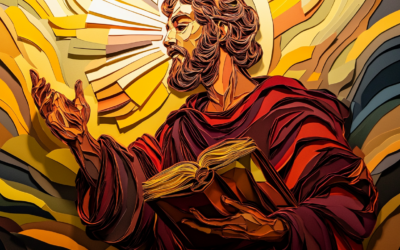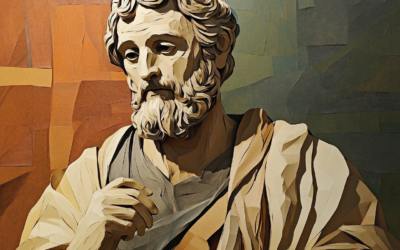Andrew: The Quiet Connector
Andrew, the brother of Simon Peter, was a fisherman from Bethsaida. Unlike his outspoken sibling, Andrew had a knack for quietly bringing people to Jesus. He was one of the first disciples, originally following John the Baptist before recognizing Jesus as the Messiah.
Early Encounters with Jesus
Andrew’s story in the Gospels starts not with Jesus but with John the Baptist. He was already a disciple of John, meaning he had been seeking after God long before he met Christ. This tells us something about Andrew. He was not just a passive believer waiting for the truth to fall into his lap. He was a seeker, a listener, a man willing to follow where God led. One day, that pursuit led him straight to Jesus.
The Gospel of John records a pivotal moment when John the Baptist pointed to Jesus and declared:
“Behold, the Lamb of God!”
John 1:36 (NASB)
For Andrew, this was a game-changing moment. John had been preaching about the coming Messiah, the one who would redeem Israel, and now he was saying that this man, Jesus, was that very Lamb of God. Andrew did not hesitate. He and another disciple, likely John, the Gospel’s author, left John the Baptist and followed Jesus. The encounter that followed is simple but powerful:
And Jesus turned and saw them following, and *said to them*, “What are you seeking?” They *said to Him*, “Rabbi (which translated means Teacher), where are You staying?” He *said to them*, “Come, and you will see.” So they came and saw where He was staying; and they stayed with Him that day.
John 1:38-39 (NASB)
Here, we see Andrew’s quiet but intentional nature. He does not burst in with demands or dramatic declarations. Instead, he follows, observes, and listens. Jesus’ response is gentle and inviting: “Come, and you will see.” It is a personal call that does not overwhelm but instead draws people in. Andrew spent the day with Jesus, and whatever he heard or experienced in those hours was enough to convince him. This was the Messiah.
Andrew’s next move is telling. He does not sit on this revelation. He does not hoard it for himself. He immediately goes to find his brother, Simon Peter, and tells him:
“We have found the Messiah” (which translated means Christ).
John 1:41 (NASB)
Notably, Andrew does not try to explain or persuade Peter with theological arguments. He does not draft a sermon. He simply brings Peter to Jesus. That act, simple and understated, changed the course of history. Peter, the brash and outspoken one, would go on to become one of Jesus’ closest disciples and the rock upon which Christ built His church. But it all started with Andrew, the quiet introducer.
This pattern of Andrew bringing people to Jesus continues throughout the Gospels. Whether it is Peter, the boy with the loaves and fishes (John 6:8-9), or the Greeks who wanted to meet Jesus (John 12:20-22), Andrew is always connecting others to Christ. He is not looking for the spotlight. He is not trying to be the leader. He simply recognizes who Jesus is and makes sure others do too.
In many ways, Andrew represents the kind of disciple often overlooked. The one who does not seek recognition but whose faithfulness has a ripple effect far beyond what they might ever see. His first recorded words in Scripture are “We have found the Messiah.” In those words, we see his heart. A heart that sought after truth, recognized it when he found it, and made sure to share it with those around him.
Role Among the Disciples
Andrew’s actions often facilitated others’ connections to Jesus. When a boy with five barley loaves and two fish was found among the crowd, it was Andrew who brought him to Jesus, leading to the miraculous feeding of the multitude:
One of His disciples, Andrew, Simon Peter’s brother, *said to Him*, “There is a lad here who has five barley loaves and two fish, but what are these for so many people?”
John 6:8-9 (NASB)
Additionally, when certain Greeks sought to meet Jesus, they approached Philip, who then consulted Andrew. Together, they facilitated the introduction:
Philip *came and told* Andrew; Andrew and Philip *came and told* Jesus.
John 12:22 (NASB)
Missionary Journeys and Martyrdom
While the New Testament offers limited details about Andrew’s later life, various traditions and apocryphal texts provide insights into his missionary activities and martyrdom. These accounts, though not canonical, have been influential in shaping the understanding of Andrew’s role in early Christianity.
Missionary Journeys
According to early Christian writings, Andrew embarked on extensive missionary journeys following Jesus’ ascension. The apocryphal Acts of Andrew, a text dating back to the second century, narrates his travels and evangelistic efforts. This work, though not included in the New Testament canon, offers a glimpse into the traditions surrounding Andrew’s missions.
One notable tradition suggests that Andrew preached in regions such as Scythia, which encompasses parts of modern-day Ukraine and southern Russia. This association is particularly significant in Eastern Orthodox Christianity, where Andrew is revered as the patron saint of several countries in that region. Additionally, some accounts propose that Andrew ministered in areas of Asia Minor, including parts of present-day Turkey, and ventured into Greece, spreading the teachings of Jesus.
Martyrdom
The manner of Andrew’s death has been a subject of various accounts, with the most prevalent tradition asserting that he was martyred by crucifixion in the city of Patras, located in Achaea, modern-day Greece. Early texts, such as the Acts of Andrew, describe his crucifixion, noting that he was bound, rather than nailed, to a cross. This method was believed to prolong suffering, serving as a testament to his unwavering faith.
Over time, a specific tradition emerged detailing that Andrew was crucified on an X-shaped cross, commonly referred to as a “Saint Andrew’s Cross.” This form of crucifixion, distinct from the traditional T-shaped cross, was purportedly chosen at Andrew’s own request, as he felt unworthy to be crucified in the same manner as Jesus. The iconography of Andrew on an X-shaped cross became prominent in medieval art and has persisted as a symbol associated with the apostle.
Scholarly Perspectives
Modern scholarship approaches these accounts with a critical lens, acknowledging the blend of historical events and legendary embellishments. The Acts of Andrew, while providing valuable insights into early Christian traditions, is considered apocryphal and is not regarded as a reliable historical document. Scholars emphasize the need to differentiate between theological narratives crafted to inspire faith and verifiable historical facts.
Despite the challenges in verifying specific details of Andrew’s missions and martyrdom, his legacy as a dedicated apostle who fervently spread the teachings of Jesus remains influential. His example underscores the profound impact that committed individuals can have in the propagation of faith, even in the absence of extensive historical records.
Scripture quotations taken from the (NASB®) New American Standard Bible®, Copyright ©, 2020 by The Lockman Foundation. Used by permission. All rights reserved. lockman.org









0 Comments